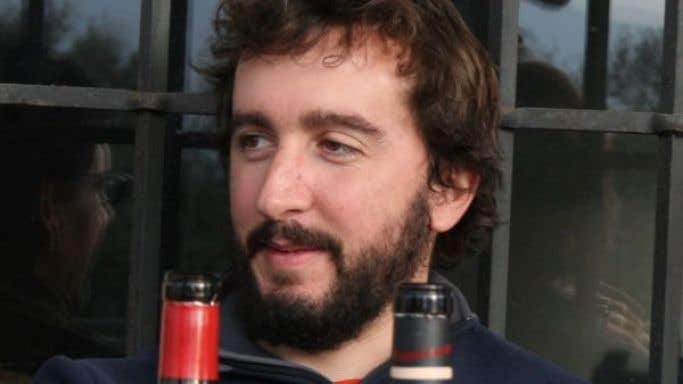From €17.15, £20.70, AU$46, 249.95 Danish krone, $33.13 (2012)
I’m rather ashamed that Daniel Gómez Jiménez-Landi (pictured here) has already produced two wines of the week, in 2009 and 2012, but his wines are just so exceptionally good that they deserve this rather repetitive enthusiasm. In fact Dani Landi has been making the sort of transparent, terroir-expressive, refreshing wines that are now ultra-fashionable since 2004 when he discovered the potential of old-vine Garnacha grown in the Gredos mountains south west of Madrid.
Julia and I tasted this wine separately recently. It was shown by Dani’s UK importer Indigo Wine profiled in this article on Monday and I tasted it at home. We both gave the wine a score of 17 out of 20, which is really very high for us meanies.
Julia wrote about it: ‘Four plots of Garnacha, in the Gredos mountains, on sandy granite. Light cherry red. Lively, peppery, crunchy dark-red fruit. Chalky/mineral tannins give a lovely dry finish. Both fruity and elegant. Long, moreish finish with a more savoury aftertaste.’
I wrote about it: ‘The label is awash with names: not just that of the producer and Las Uvas de la Ira (disconcertingly written IRA), but also Sierra de Gredos, Valle del Tiétar, Vino del Pueblo and El Real de San Vicente. Take your pick. Garnacha from the middle of Spain. Light and fresh with real wet-stony sensation on the finish – light years from the classic concentrated Garnacha. Really lifted and refreshing. Very muscular and ambitious. Extremely sophisticated. Lots of sweet juice but no weight. And a bone dry finish in which the alcohol is barely perceptible. 14.5% Drink 2015-20’
I hope this gives you enough of an idea of how this truly lovely wine tastes. As for the proper names, the Valle del Tiétar is the valley in which Dani Landi specialises, one of the wettest in the Gredos mountains with some villages notching up as many as 1000 mm of rain a year. Vino del Pueblo explains that this is a village wine, and the village in this instance is El Real de San Vicente about which Dani writes, ‘I work a total of seven hectares located between 750 and 1,000 m altitude with granite and slate soils depending on the vineyard. Most of the 15,000 bottles I make each year are a village wine, Las Uvas de la Ira, from El Real de San Vicente. But I also work three vineyards that are bottled separately for their special qualities and expression. Each one of these wines reflects a specific landscape and place: Cantos del Diablo, El Reventón and Las Iruelas.’
A white Uvas de la Ira is also made, from the excellent local grape Albillo Real. Julia gave this a very enthusiastic 17.5. Just take care when following our Find this wine link.
The technical sheet for red Las Uvas de la Ira mentions some sandy soils too and an average vineyard age of 60 to 70 years. Grapes are picked in late September and whole bunches fermented in open-topped oak fermenters with ambient yeast. He is careful to treat the grapes gently with no pump-overs or aggressive extraction – has never sought the heavily oaked, concentrated style that was so prevalent in Spain when he started out – and aged 10 months in used 2,000-litre and 3,000-litre French oak foudres. There is no filtration or stablisation before the wine is put into just 12,000 bottles.
Considering this small production, the wine is surprisingly well distributed. Although Wine-searcher.com lists no US retailer of this 2013, I see the 2012 is available in the US. We have not tasted it but I definitely think it worth investigating. The 2013 is widely available in Spain, in independent retailers such as Bottle Apostle, The Sampler, Handford Wines and St Andrews Wine Company in the UK, as well as in Harvey Nichols. You can find it online at Cru, and also in the Netherlands, Belgium, Denmark and Australia.
All these wines are very well worth seeking out.


